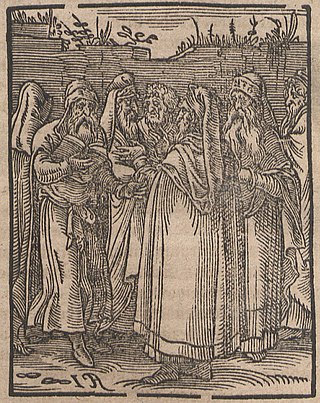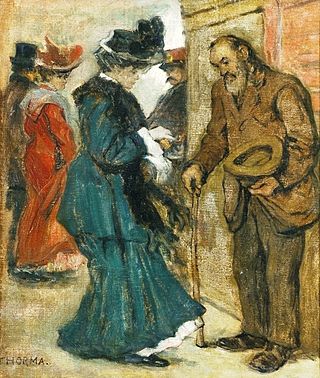
In Judaism, the concept of the Jews as chosen people is the belief that the Jews as a subset, via partial descent from the ancient Israelites, are also chosen people, i.e. selected to be in a covenant with God. Israelites being properly the chosen people of God is found directly in the Book of Deuteronomy 7:6 as the verb baḥar (בָּחַר), and is alluded to elsewhere in the Hebrew Bible using other terms such as "holy people" as goy or gentile, Book of Exodus 19:6. Much is written about these topics in rabbinic literature. The three largest Jewish denominations—Orthodox Judaism, Conservative Judaism and Reform Judaism—maintain the belief that the Jews have been chosen by God for a purpose. Sometimes this choice is seen by believers as charging the Jewish people with a specific mission—to be a light unto the nations, and to exemplify the covenant with God as described in the Torah.

Kabbalah or Qabalah is an esoteric method, discipline and school of thought in Jewish mysticism. A traditional Kabbalist is called a Mekubbal. The definition of Kabbalah varies according to the tradition and aims of those following it, from its origin in medieval Judaism to its later adaptations in Western esotericism. Jewish Kabbalah is a set of esoteric teachings meant to explain the relationship between the unchanging, eternal God—the mysterious Ein Sof —and the mortal, finite universe. It forms the foundation of mystical religious interpretations within Judaism.

Alms are money, food, or other material goods donated to people living in poverty. Providing alms is often considered an act of charity. The act of providing alms is called almsgiving.

The Musar movement is a Jewish ethical, educational and cultural movement that developed in 19th century Lithuania, particularly among Orthodox Lithuanian Jews. The Hebrew term Musar (מוּסַר) is adopted from the Book of Proverbs (1:2) describing moral conduct, instruction or discipline, educating oneself on how one should act in an appropriate manner. The term was used by the Musar movement to convey the teachings regarding ethical and spiritual paths. The Musar movement made significant contributions to Musar literature and Jewish ethics. The movement has been revived in the 21st century amongst Jews of all denominations, particularly in the United States.

Tzadik is a title in Judaism given to people considered righteous, such as biblical figures and later spiritual masters. The root of the word ṣadiq, is ṣ-d-q, which means "justice" or "righteousness". When applied to a righteous woman, the term is inflected as tzadika/tzaddikot.
Seudah shlishit or shaleshudes is the third meal customarily eaten by Sabbath-observing Jews on each Shabbat. Both names refer to the third of the three meals a Jew is obligated to eat on Shabbat according to the Talmud.
Although rare, there are instances within Jewish law that mandate a Jew to sacrifice their own life rather than violate a religious prohibition. One of these prohibitions is that no life should be taken, including one's own. Many more ritual prohibitions exist as well, which means that under limited circumstances a Jew has to self-sacrifice when the greater good calls for breaking a more minor dictate. This practice reflects the practical and perhaps malleable nature of Judaic law.
Yedid Nefesh is the title of a piyyut and zemer. It is usually sung on Shabbat.
Pikuach nefesh, which means "saving a soul" or "saving a life," is the principle in Halakha that the preservation of human life overrides virtually any other religious rule of Judaism. In the event that a person is in critical danger, most mitzvot, including the Ten Commandments of the Torah, become inapplicable if they would hinder the ability to save oneself or someone else. However, there are certain exceptions; some rules and commandments may not be broken under any circumstances and thus may require an act of self-sacrifice.
In Judaism, angels are supernatural beings that appear throughout The Tanakh, rabbinic literature, apocrypha and pseudepigrapha, Jewish philosophy and mysticism, and traditional Jewish liturgy as agents of the God of Israel. They are categorized in different hierarchies. Their essence is often associated with fire. The Talmud describes their very essence as fire.

Rabbi Elazar ben Moshe Azikri (1533–1600) was a Jewish kabbalist, poet and writer.
In Judaism, views on abortion draw primarily upon the legal and ethical teachings of the Hebrew Bible, the Talmud, the case-by-case decisions of responsa, and other rabbinic literature. While all major Jewish religious movements allow or encourage abortion in order to save the life of a pregnant woman, authorities differ on when and whether it is permitted in other cases.
Judaism offers a variety of views regarding the love of God, love among human beings, and love for non-human animals. Love is a central value in Jewish ethics and Jewish theology.
Forbidden relationships in Judaism are intimate relationships which are forbidden by prohibitions in the Torah or rabbinical injunctions.
Musar literature is didactic Jewish ethical literature which describes virtues and vices and the path towards character improvement. This literature gives the name to the Musar movement, in 19th century Lithuania, but this article considers such literature more broadly.

Tumtum is a term that appears in Jewish Rabbinic literature. It usually refers to a person whose sex is unknown because their genitalia are hidden, undeveloped, or difficult to determine.

Kochos/Kochot haNefesh, meaning "Powers of the Soul", are the innate constituent character-aspects within the soul, in Hasidic thought's psychological internalisation of Kabbalah. They derive from the 10 Sephirot Heavenly emanations of Kabbalah, by relating each quality to its parallel internal motivation in man. The Hasidic discussion of the sephirot, particularly in the Kabbalistically oriented system of Habad thought, focuses principally on the Soul Powers, the experience of the sephirot in Jewish worship.
Jewish vegetarianism is a commitment to vegetarianism that is connected to Judaism, Jewish ethics or Jewish identity. Jewish vegetarians often cite Jewish principles regarding animal welfare, environmental ethics, moral character, and health as reasons for adopting a vegetarian or vegan diet.

Brant Rosen is an American rabbi and blogger, known for his pro-Palestinian activism.
Ana BeKoach is a piyyut recited by Jewish communities at the end of Parshat HaKorbanot read during Shacharit, as part of Kabbalat Shabbat, and on each day from the second day of Pesach to the day before Shavuot during the 49-day counting of the Omer. It takes its name from the first two words of the first verse.







